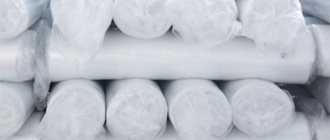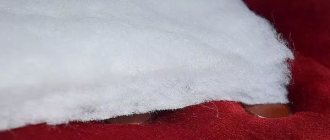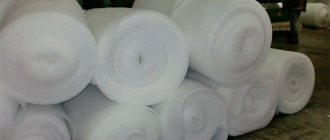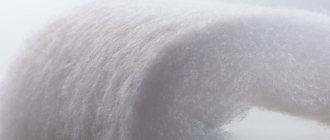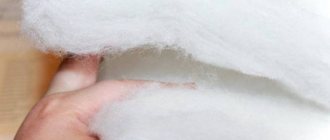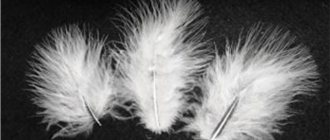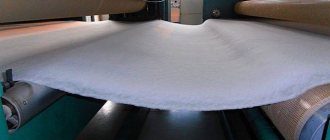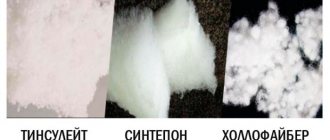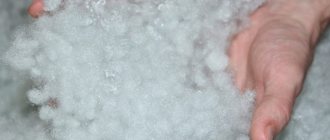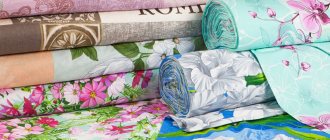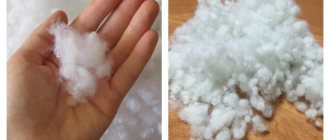Sintepon
Sintepon is made from polyester fibers. The material was developed in England in 1935. Since then, fused thermoplastic fibers have been used not only in their pure form, but also in combination with natural materials: threads of cotton, wool or bamboo.
Under a microscope, padding polyester fibers look like many spirals or springs intertwined with each other.
This material turned out to be an excellent replacement for natural insulation materials - feather, down and wool. Synthetic winterizer is much more practical than natural ones because:
- easy;
- retains heat for a long time;
- does not deform under compression;
- it can be washed in a machine;
- dries quickly;
- does not absorb moisture and sweat;
- it does not harbor feather mites and fungus;
- hypoallergenic material;
- affordable.
What is attractive about clothes with padding polyester insulation?
You can insulate yourself in different ways - sweaters, jackets, cardigans and other items still cannot replace a woman's warm coat, suitable for any weather. Sintepon has been used as an insulating element for a long time; it is a lightweight synthetic non-woven material that does not cause allergies and retains heat well. Varieties of this material: padding polyester, sherstepon, padding polyester on silicone have somewhat different thermoregulatory qualities, but retain and enhance the main positive abilities:
- warm, light;
- beautiful, varied;
- creating, maintaining and restoring shape;
- ideal for any figure;
- relatively inexpensive;
- easy to care for, washable.
The most modest model can serve as the basis for creating an individual style. Many styles allow you to visually correct your figure, a plump lady appears slimmer, a short lady appears taller. Large coats do not look huge, even winter ones, with significant insulation.
The upper material of products with synthetic insulation is usually waterproof, for the most part it is polyester. The “Bologna” fabric, familiar to the older generation, is still relevant and looks great on autumn coats. The color range is endless, as are the options for the fabric itself - denser, softer or stiffer. The lining is predominantly natural, especially in models for the younger generation. Usually these are three-layer clothes:
- fabric covering;
- insulating layer;
- lining.
Light white non-woven insulation of good quality is smooth, uniform, and easily clings to the fabric base with the finest polyester fibers. Depending on the style, the coat can be quilted with large squares and curly stitching. Craftswomen make convex patterns, stripes and flowers.
Holofiber
Insulation made of 100% polyester hollow structure. The material is produced in the form of balls or webs consisting of tightly twisted spirals. The air between the holofiber microparticles heats up quickly and retains heat for a very long time. At the same time, sufficient air flow is ensured and the body in such clothes does not overheat.
Holofiber appeared later than padding polyester, but at the moment it is more in demand among clothing manufacturers because:
- air circulates better between the particles of the material;
- does not absorb moisture;
- holds dust on the surface, preventing it from penetrating inside;
- the filler does not absorb odors;
- retains its shape;
- does not ignite;
- dries quickly;
- Machine washable;
- acceptable price.
Definition
Hollofiber is a non-woven material made of pure polyester, produced by thermal bonding.
Sintepon is a non-woven material used as filler and insulation in the production of many products.
What filling for jackets and promotional vests is most often preferred?
A draft at the cash register, or constant movement from the premises to the terrace of a restaurant or cafe can provoke ARVI among staff. It is better to equip employees with suitable clothing in advance than to urgently look for someone to “plug holes” in the work schedule.
Ask a Question
People most often order holofiber vests from us and argue that:
- the material is inexpensive;
- easy;
- perfectly warms;
- and also does not absorb odors, which is important, because clothes smelling in the smoking room will spread a stale smell.
Sintepon is inferior in quality to holofiber; it:
- electrified;
- worse air permeability;
- can absorb unpleasant odors;
- warms better than natural materials, but worse than holofiber.
Usually, workwear made from holofiber, including jackets and vests, is dry-cleaned, but washing it yourself in a machine at a temperature of 30°C is acceptable and will not harm the product.
It is important to take into account temperature standards, because the density of the holofiber determines at what temperature it will be most effective.
| Holofiber density | Minimum operating temperature | Maximum operating temperature |
| 100 g/m2 | +5°С | +10°С |
| 150 g/m2 | -10°С | +5°С |
| 200 g/m2 | -20°С | -10°С |
| 300 g/m2 | -30°С | -20°С |
Differences from other materials - table
| Material name | Lifetime | Resistance to deformation | Breathability | Environmental friendliness and safety | Thermal insulation | Price |
| Holofiber | long | high | good | high | high | average |
| Sintepon | short | low | bad | low | average | low |
| Sintepooh | short | low | average | average | high | average |
| Pooh | long | low | good | high | average | high |
| Bamboo | long | average | good | high | high | high |
| Thinsulate | long | average | good | average | high | high |
| Comforel | short | average | bad | low | average | low |
A warm vest is a contribution to business prosperity
What does a company owner get by ordering promotional clothing for staff? Expenses - yes, but not only. In one action, he solves two issues:
- Forms a positive image of the brand among its customers, because looking at a nice vest, they remember the logo and associate it with a neat and high-quality item;
- Forms a positive attitude of staff towards the brand in general and towards management in particular. An employee in warm clothes feels taken care of and becomes more loyal to the manager, which means he works more actively.
The logo is the head of everything
Promotional clothing without a logo is meaningless. That is why we put the company logo or other image approved by the customer on the vests. The application method depends on the chosen fabric and the project budget.
- Print is a fairly economical option, but the least durable. Will withstand several dozen washes.
- Embroidery is solid and bright. After a few years, even a well-worn vest will delight the eye with the shine of the silky threads with which we will embroider your logo. Lasts for years.
- Thermal transfer and sublimation - durable and strong like embroidery. The only difference is that the image is applied to a special material, and then transferred to the fabric of the product using a thermal method, rather than embroidered on it.
How to care for products
Outerwear, blankets and other products made from holofiber can be safely washed in an automatic machine, but the temperature regime must be observed. Water should not exceed 40 degrees. The material can also be washed by hand with pre-soaking. Products can be ironed and steamed.
Holofiber items can be dried in a washing machine that has the appropriate function. To care for products containing this material, it is recommended to use liquid detergents instead of powders. They are much easier to rinse out of holofiber.
Pillows and blankets made from this material should be washed using the delicate cycle. You will need 2 times less powder than when washing ordinary things, otherwise its residues will linger in the fibers. Spinning will not damage the holofiber; the pillow will quickly restore its shape after drying.
The furniture is also easy to care for. If dirt appears on the woven surface, you will need to treat it with a special powder or use laundry soap, after wetting the stained area. Then carefully clean the area of contamination with a sponge and warm water.
If the holofiber can be pulled out, this will make it easier to care for furniture with such filling. It is enough to remove the layer, wash the cover, and air the material itself on the balcony. You don't need to do anything else with it. If the holofiber cover is always clean, then this is enough. If the layer itself is dirty, then you can use washing gel diluted in warm water (1 tablespoon of product per 2 liters of water). Wet the sponge in the solution and thoroughly rub the stained area. Then let the surface dry and then use the cover.
You cannot wash the material without a fabric bag. It is not recommended to remove fibers from the pillow and rinse them separately, otherwise the structure will be damaged.
The author of these lines has a holofiber down jacket. It is easy and simple to wash when it gets dirty. I set the delicate mode and temperature to 40 degrees. I wash my down jacket for an hour. When using powder, I turn on the additional rinse mode. The down jacket dries in just a couple of hours. Unlike synthetic down and synthetic padding, the material does not roll into lumps after washing and the clothes look like new.
